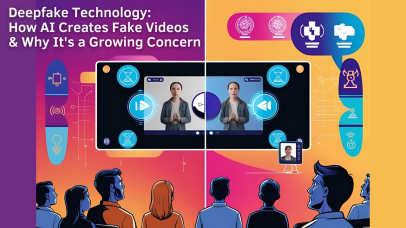AI in Agriculture in 2025: Transforming Indian Farms for a Sustainable Future
Farming in India is now changing rapidly. Where earlier farming was done in the old way, now the same work is being done with wisdom and new techniques.

Imagine that you are watching a video in which a political leader is announcing a war or your favorite celebrity is advertising a product, but after a deep observation, you realize that the leader or celebrity in the video you are watching is not real but has been created by technology, meaning it is a fake video. No wonder, because this video is created by deepfake technology.
From the memes you see online today to dangerous political propaganda, deepfake technology is giving a new form to everything. But what exactly is this technology, how has it been created using artificial intelligence, and why should you care about the use of this technology?
If you are a student, a technology lover, or even an entrepreneur or businessman, understanding deepfake technology is not just a choice but an absolute necessity for you.
Let’s understand this online trend together.
What Is Deepfake Technology?
The word deepfake is made up of "deep learning" and "fake." It refers to such media in which mainly any video in which the face or voice of a person is replaced with someone else's face or voice using an AI algorithm. Due to this, the video looks completely real, and it becomes very difficult to differentiate whether it is real or fake.
Deepfakes are not limited to just faces or voices. Now, with its help, you can create someone's distorted voice, copy the whole body, i.e., create a body like someone else's, and even create AI-generated news anchors and much more.
How Deepfakes Work: A Peek Behind the Curtain
At the core of deepfakes is deep learning, a subset of machine learning that mimics the way the human brain processes data. Here's how it works in simple steps:
Data Collection: It can collect thousands of images or videos of any subject.
Training the neural network: An AI model called a generative adversarial network (GAN) is trained on this data.
Face Mapping and Rendering: With the help of AI, you can superimpose a face onto another person's body and give it a natural look by coordinating lip movements and facial expressions.
Polishing: The final video is refined to reduce errors and increase realism.
This technology, while impressive, raises a red flag.
Why Are Deepfake Videos a Growing Concern?
While deepfake technology can be entertaining and even revolutionary in fields such as entertainment and gaming, it also has a dark side.
1. Political Manipulation & Misinformation
Fake political speeches or interviews can mislead the public, rig elections, or incite violence. During major elections, deepfakes are often weaponized for misinformation campaigns.
2. Personal Privacy & Harassment
Deepfake porn, in which people's faces are superimposed onto explicit content without consent, is one of the most dangerous forms of abuse. Women are disproportionately targeted, causing trauma and reputational damage.
3. Corporate & Financial Scams
Scammers now use deepfake voice technology to pretend to be CEOs in fake scam calls or fake video meetings, causing companies to lose millions.
4. Losing of Trust
As deepfakes become more realistic, it becomes harder to trust what we see online. In a world where "seeing is believing", this could erode people's trust in the media, legal evidence, and even social interactions.
Real-World Examples of Deepfakes
Barack Obama PSA by Jordan Peele: A viral video in which Obama appears to say worrying things was later revealed to be a deepfake video to raise awareness.
Tom Cruise TikTok Deepfakes: A series of ultra-realistic videos featuring a fake Tom Cruise created by a visual effects artist using AI.
UK fraud case: A company executive was tricked into transferring $243,000 after receiving a phone call imitating his boss’s voice – which was generated using AI.
The Positive Side of Deepfake Technology
Surprisingly, not all deepfakes are malicious. There are legitimate uses for this technology across a variety of industries, and it's extremely helpful:
Movies and TV: It is used in movies to de-age actors or bring deceased cast members back on screen (e.g., Carrie Fisher in Star Wars).
Language dubbing: AI can now sync mouth movements with audio dubbed in different languages.
Education & Museums: Historical figures can be “brought to life” for interactive learning experiences.
How to Spot a Deepfake: Stay One Step Ahead
AI is evolving, but so are detection tools. Here's how you can spot a deepfake
Pay attention to the eyes: One easy way to catch deepfakes is to pay attention to the eyes in the videos, as they often fail to simulate natural blinking or eye movements.
Check for unnatural facial movements: If you see an asymmetrical jaw, blurry lips, or a stiff expression, it could be a deepfake.
Audio-video mismatch: If lip-sync is off, or the words come first and the lips move later, it could be a deepfake.
Use detection tools: Platforms like Microsoft's Video Authenticator or Deepware Scanner can help detect fake videos.
Can We Stop Deepfakes? The Fight Against AI Fakery
Governments, tech giants, and startups are working hard to combat deepfakes.
1. Legislation and Policies
Countries such as the US, China, and the European Union have enacted laws that criminalize the malicious use of deepfake technology, particularly in elections and pornography.
2. AI Detection Tools
Google, Facebook, and MIT are investing in tools that can detect manipulated media using reverse GANs and digital forensics.
3. Blockchain Verification
Some startups use blockchain to verify the authenticity of videos by applying a timestamp to the original footage and comparing it with suspected deepfakes.
Conclusion:
Deepfake technology is both fascinating and scary. As AI gets smarter, so must we.
Whether you’re a student studying media, looking for a job in AI or cybersecurity, or an entrepreneur trying to build trust in the digital space, understanding deepfakes gives you an important advantage.
Have thoughts on deepfakes or real-life experiences to share?
Farming in India is now changing rapidly. Where earlier farming was done in the old way, now the same work is being done with wisdom and new techniques.
Nowadays, the world is changing very fast. Many new things and technologies are coming. One such technology is Artificial Intelligence (AI). AI means the ability of computers and machines to think and work like humans. This technology is now being used in every field, and education is also not untouched by it.
In the last 2-3 years, AI has changed so much that it has transformed every industry. It has completely changed the way of work. Every second, a new AI tool is coming and making some work easy and fast. The work that used to take many days or months earlier is now being done in just a few seconds, this is no less than a miracle.

Our free career counseling services are designed to help you navigate your professional journey with confidence. Our expert counselors provide personalized guidance, helping you explore career options, set goals, and develop strategies to achieve them.
Signup Now